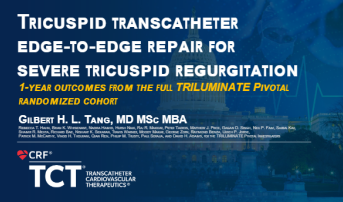DRAMI: No Clear Winner for Distal vs Traditional Radial Access in STEMI
A clinically relevant question without a definitive answer means larger trials are needed to provide clarity, the investigators say.

WASHINGTON, DC—A new randomized trial presented here at TCT 2024 offers no clear answer on how distal radial access performs as an alternative to conventional transradial access in patients with STEMI scheduled to undergo PCI.
The puncture success rate was slightly lower with distal radial access in the intention-to-treat analysis (94.3% vs 96.1%), a difference that failed to establish the noninferiority of the approach. The results were similar in a per-protocol analysis, although an as-treated analysis showed that distal access was noninferior to the conventional transradial approach, Jun-Won Lee, MD, PhD (Yonsei University College of Medicine, Seoul, Republic of Korea), reported here at TCT 2024.
“A well-designed, large-scale RCT is needed to confirm this result,” Lee told meeting attendees.
At a press conference, Juan Granada, MD (Cardiovascular Research Foundation, New York, NY), said this is “an important topic for the interventional cardiologists today.”
The result of this trial “is going to make some people unhappy,” he commented. “People continue to push the boundaries by going smaller and trying to get safer and better ways to do things. But [distal radial artery puncture] is a procedure that requires more expertise, more experience, and in some centers actually takes longer. But people say you avoid occluding the radial artery, which is a big advantage for the patient.”
Indeed, prior studies have suggested that going through the distal radial artery—located over the bony surface in the anatomical “snuffbox”—provides better preservation of persistent antegrade blood flow during hemostatic compression than does traditional transradial access, Lee said, and there are some data suggesting a reduced rate of radial artery occlusion and fewer bleeding complications.
In guidelines, transradial access have been recommended as a way to reduce bleeding complications and mortality in the setting of STEMI, but evidence supporting the use of distal radial access is limited, he added.
No Differences in Clinical Outcomes
The DRAMI trial, performed across three hospitals by operators with at least 100 cases of experience with distal radial access, was designed to fill that gap. Investigators randomized 354 patients (mean age 63.3 years; 80.8% men) with STEMI to either distal radial access or conventional transradial access; operators were instructed to switch access sites if the puncture was not successful within 5 minutes.
Initial access was more likely to be on the left side for distal versus conventional access (91.5% vs 60.7%), with more contrast used for distal access (median 150 vs 140 mL; P = 0.014). Other procedural characteristics were similar in the two groups, with a 5.4% rate of crossover to another access location, including 2% to the femoral artery. There were no differences in puncture time, the length of the procedure, fluoroscopic time or dose, or the time to hemostasis.
The primary endpoint was the rate of puncture success, with a noninferiority margin of 5.65%. The rate was slightly lower in the distal radial group, with the risk difference establishing noninferiority only in the as-treated analysis (-1.17%; 95% CI -5.56% to 3.22%; P = 0.023).
A well-designed, large-scale RCT is needed to confirm this result. Jun-Won Lee
Coronary angiography success was 100% and PCI success was 99.7%, with no differences between access types. There were also no significant differences between distal and conventional radial access in overall bleeding complications (4.5% vs 5.1%; P = 0.822) or access-site bleeding (2.3% vs 3.4%; P = 0.750).
Through 1 month of follow-up, one patient developed radial artery occlusion (in the conventional group) and one developed hand swelling or pain (in the distal group). There were three cases of neuropathy—one after distal radial access and two after conventional access.
Risks of MACE (all-cause death, any MI, or any revascularization) and the individual components were no different by access type (P > 0.05 for all).
A Backup Option
Serving as the discussant following Lee’s presentation, Sripal Bangalore, MD (NYU Langone Health, New York, NY), noted that he and his colleagues recently published a network meta-analysis of 47 RCTs of patients undergoing coronary angiography or PCI to compare four access types: femoral, distal radial, conventional radial, and ulnar. They conclude based on differences in risks of access-site hematoma and bleeding that “distal radial and ulnar access can be considered as a default secondary access site before considering femoral access.”
Those trials, however, excluded patients with STEMI, making DRAMI “very clinically relevant because we do not have data on distal radial in STEMI patients,” Bangalore said.
The trial was ultimately underpowered to answer the question, he pointed out, adding that DRAMI will not change his practice or push him to use distal radial as a default access approach in patients with STEMI.
“But the one thing that this trial tells us is distal transradial is feasible,” Bangalore said, noting that the rate of crossover to femoral access in DRAMI was half of what was observed in MATRIX. “As such, I’m more likely to use distal radial as a default secondary access.”
Speaking with TCTMD, B. Hadley Wilson, MD (Sanger Heart & Vascular Institute, Atrium Health, Charlotte, NC), past president of the American College of Cardiology, also said the results are unlikely to change practice, especially in the United States, where distal radial access is not commonly used.
The technique is “moderately more difficult” than traditional transradial access, Wilson said, noting that all the operators in DRAMI were experienced with the distal approach.
“It’ll take quite a bit of time for people to get experience with that if they want to pursue that,” he said. “The flip side is that people are quite comfortable now with radial access, even in fast STEMI procedures. So a lot of times people will just stick with what they think is going to work reliably for them in patients that are so acutely ill, and probably it will be difficult for them to justify moving on to this procedure when they’ve had success with the traditional procedure, without the results showing dramatic difference in MACE or complications.”
Todd Neale is the Associate News Editor for TCTMD and a Senior Medical Journalist. He got his start in journalism at …
Read Full BioSources
Lee J-W. Comparison of puncture success rate between distal radial access and transradial access in patients with ST-elevation myocardial infarction: DRAMI trial. Presented at: TCT 2024. October 28, 2024. Washington, DC.
Disclosures
- The trial was funded by Hanmi Pharmaceutical.
- Lee reports grants/research support Hanmi Pharmaceutical and consulting fees/honoraria from Abbott Vascular, Yuhan, Boryoung, SamJin Pharmaceutical, ChongKunDang, HK inno.N, Novartis, Boehringer Ingelheim, AstraZeneca, Medtronic, Amgen, Sanofi, Boston Scientific, Daiichi Sankyo, Daewoong Pharmaceutical, Biosensors, Dong-A ST, and JW Pharmaceutical.
- Granada reports being co-founder and co-inventor for Cephea Valve Technologies, which was acquired by Abbott.
- Wilson reports no relevant conflicts of interest.






Comments